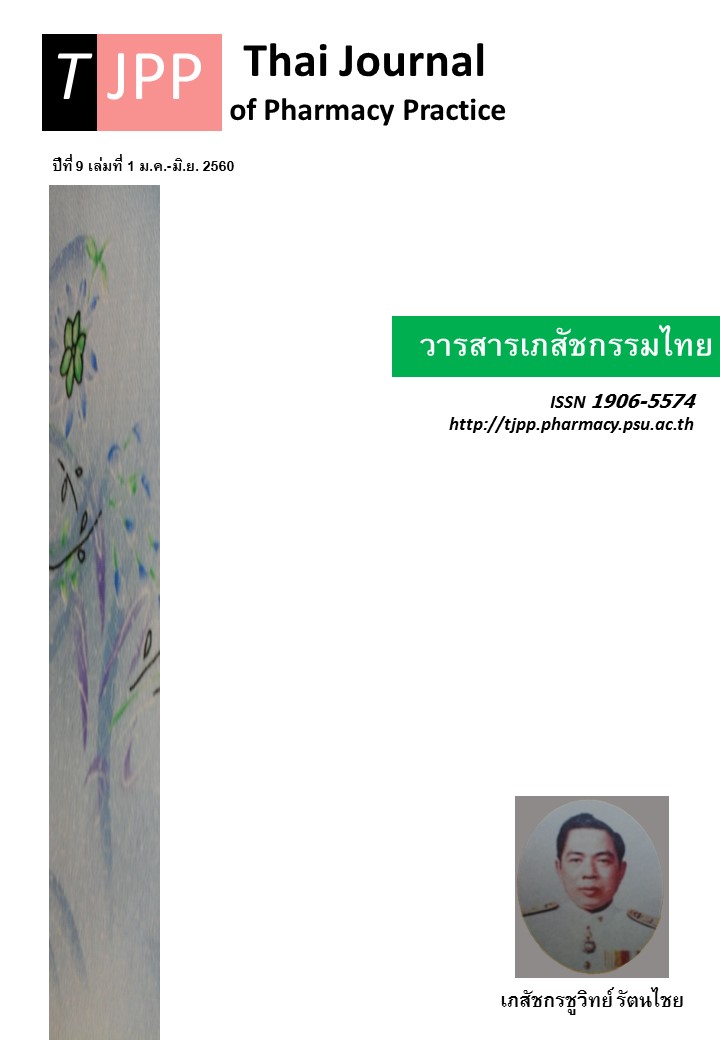สถานการณ์ยาและผลิตภัณฑ์เสริมอาหารในเขตสุขภาพที่ 3
Main Article Content
บทคัดย่อ
วัตถุประสงค์: เพื่อศึกษาสถานการณ์การใช้ยาและปัญหาความไม่ปลอดภัยด้านยาและผลิตภัณฑ์เสริมอาหารในเขตสุขภาพที่ 3 วิธีการ: การวิจัยนี้เป็นการวิจัยเชิงพรรณนาที่ศึกษาข้อมูลระดับบุคคล ระดับครอบครัว และระดับชุมชน กลุ่มตัวอย่าง คือ ผู้ป่วยโรคเรื้อรัง 717 คน ซึ่งเลือกมาแบบสุ่มอย่างง่ายจากผู้ป่วยเรื้อรังที่อาศัยใน 5 ตำบลที่เลือกมาแบบตามสะดวก จังหวัดละ 1 ตำบลจากทั้งหมด 5 จังหวัดในเขตสุขภาพที่ 3 ตัวอย่างอาศัยใน 599 ครัวเรือน อาสาสมัครสาธารณสุขที่ผ่านการอบรมเป็นผู้ช่วยวิจัยเก็บข้อมูลการใช้ยา ตลอดจนยาและผลิตภัณฑ์เสริมอาหารที่ไม่ปลอดภัยในครัวเรือนด้วยการสัมภาษณ์ การสังเกต การทดสอบผลิตภัณฑ์ที่ต้องสงสัยด้วยชุดทดสอบเบื้องต้น การตรวจสอบความถูกต้องของฉลากจากฐานข้อมูลของสำนักงานคณะกรรมการอาหารและยา และการตรวจสอบผลิตภัณฑ์จากฐานข้อมูลผลิตภัณฑ์ที่ไม่ปลอดภัยของกรมวิทยาศาสตร์การแพทย์ เภสัชกรและผู้ช่วยวิจัยสำรวจผลิตภัณฑ์ที่ห้ามจำหน่ายในร้านชำหรือร้านค้าทุกแห่งในทั้ง 5 ตำบลรวม 121 ร้าน ผลการวิจัย: ผู้ป่วยจำนวนมากมีปัญหาในการอ่านฉลากยา การเพิ่มหรือลดยาด้วยตนเอง และการไม่แยกเก็บยากินและยาใช้ภายนอกออกจากกัน ร้อยละ 33.61,14.23 และ 11.85 ตามลำดับ ครัวเรือนใช้ยาและผลิตภัณฑ์เสริมอาหารที่ไม่ปลอดภัย ร้อยละ 10.52 (63/599 ครัวเรือน) รวม 112 รายการ ในจำนวนนี้ ร้อยละ 61.61 (69/112 รายการ) เป็นยาไม่มีทะเบียนและ/หรือตรวจพบสารสเตียรอยด์ หรืออวดอ้างสรรพคุณ ยาชุด ผลิตภัณฑ์เสริมอาหารไม่มีเลขสารบบและ/หรือตรวจพบสารสเตียรอยด์ หรืออวดอ้างสรรพคุณ และยาปฏิชีวนะร้อยละ 53.62, 23.19, 20.29 และ 2.90 ตามลำดับ แหล่งที่มาของผลิตภัณฑ์ที่ไม่ปลอดภัย คือ ลูกหลาน/เพื่อนบ้าน ร้านยา และร้านชำ ร้อยละ 28.99, 23.19 และ 21.74 ตามลำดับ ในระดับชุมชน พบร้านชำจำหน่ายยาที่ห้ามจำหน่าย ร้อยละ 67.77 (82/121 ร้าน) พบยาที่ห้ามจำหน่ายตามกฎหมาย จำนวน 242 รายการ ส่วนใหญ่เป็นยาบรรเทาหวัด ยาปฏิชีวนะ และยาแก้ปวดร้อยละ 29.75, 21.90 และ 18.60 ตามลำดับ แหล่งที่มาของยาที่ห้ามจำหน่ายในร้านชำส่วนใหญ่มาจากร้านยา ร้านชำ และรถเร่ ร้อยละ 84.71, 9.09 และ 2.07 ตามลำดับ สรุป: ปัญหายาและผลิตภัณฑ์เสริมอาหารที่ไม่ปลอดภัยยังคงพบมากในเขตสุขภาพที่ 3 ทั้งในระดับบุคคล ครอบครัว และชุมชน จึงควรมีมาตรการที่เหมาะสมในการคุ้มครองผู้บริโภค
Article Details
ผลการวิจัยและความคิดเห็นที่ปรากฏในบทความถือเป็นความคิดเห็นและอยู่ในความรับผิดชอบของผู้นิพนธ์ มิใช่ความเห็นหรือความรับผิดชอบของกองบรรณาธิการ หรือคณะเภสัชศาสตร์ มหาวิทยาลัยสงขลานครินทร์ ทั้งนี้ไม่รวมความผิดพลาดอันเกิดจากการพิมพ์ บทความที่ได้รับการเผยแพร่โดยวารสารเภสัชกรรมไทยถือเป็นสิทธิ์ของวารสารฯ
เอกสารอ้างอิง
2. Manager Online. Pharmacy assistant died from eating weight loss pills “Mang Luk” widespread across Konkan. [online]. 2016 [cited Jan 4, 2017]. Available from: www.manager.co.th/QOL/ViewNew s.aspx?NewsID=9590000117952
3. Sukamolson S, Sriviriyanuparp W, Kulsomboon V. Priority prevalence and geographic distribution of unsafe products in Thailand. Journal of Health Systems Research 2016;1: 65-79.
4. Pulsukserm P. Evaluation of management model for sterolol abuse problem in Uthaithani Province. FDA Journal 2016: 42-51.
5. Food and Drug Administration. General information on health products [online]. 2017 [cited Jan 3, 2017]. Available from: wwwapp1.fda.moph.go.th/ consumer/conframe.asp.
6. Department of Medical Sciences. Single window [online]. 2017 [cited Jan 3, 2017]. Available from: www.tumdee.org/alert
7. Department of Medical Sciences. Steroid test Kits [online]. 2016 [cited Jan 15, 2017]. Available from: www.dmsc.moph.go.th/bkm/product_detail.php?id=24
8. Ministry of Public Health. Health data center: data summary of 43 files of chronic diseases [online]. 2016. [cited Jan 16, 2017]. Available from: hdcservI ce.moph.go.th/hdc/admin/monitor43hdcservice.php
9. Suksri H, Sriring P. The study of problems in self-remedy of patients in muang khon kaen district, Khon Kaen Province [online]. 2011 [cited Dec 12, 2016]. Available from: cscd.kku.ac.th/2016/uploads /proceeding/060911_153105.pdf
10. Asipong S. Health product use behavior with no medical indications among patients with chronic diseases at Rasi Salai, Sisaket Province. Thai Journal of Pharmacy Practice 2015 7: 105-13.
11. Rajatanavin R, Thakkinstian A, Chailurkit L, Svangariyaskul A, Sooksriwong C, Pongcharoen- suk P, et al. Prevalence of overt manifestation of steroid abuse without medical indication: The Thailand Research Fund; 2007. Contract No.: RDG4630208. Faculty of Medicine Ramathibodi Hospital.
12. Sungtong W. Prevalence of grocery stores with antibiotics selling at Maesuai district, Chiang Rai Province and its affecting factors. Thai Journal of Pharmacy Practice 2015; 7: 38-46.
13. Ajsri P, Sujarit J, Pengngam S, Manthaisong R, Kittbunyakun P, Knowledge, attitude, behavior and factors related to the management of chronic pain in non-cancer patients [editorial]. Isan Journal of Pharmaceutical Sciences 2014; 9:180.
14. Buri Ram Provincial Public Health Office. Academic works in the area of drug system and consumer protection and Thai traditional and alternative medicines [online]. 2013 [cited Jan 4, 2017]. Available from: http://www.bro.moph.go.th/ html/downloads/STRATEGY/innovation/PDF_Research_5355/04.drug-traditional.pdf.
15. Booddawong B, Yoongthong W. Community empowerment in the management of the problems on inappropriate drugs and health products: case study of Nonkhun district, Sisaket province. Thai Journal of Pharmacy Practice 2016; 8: 331-43.


